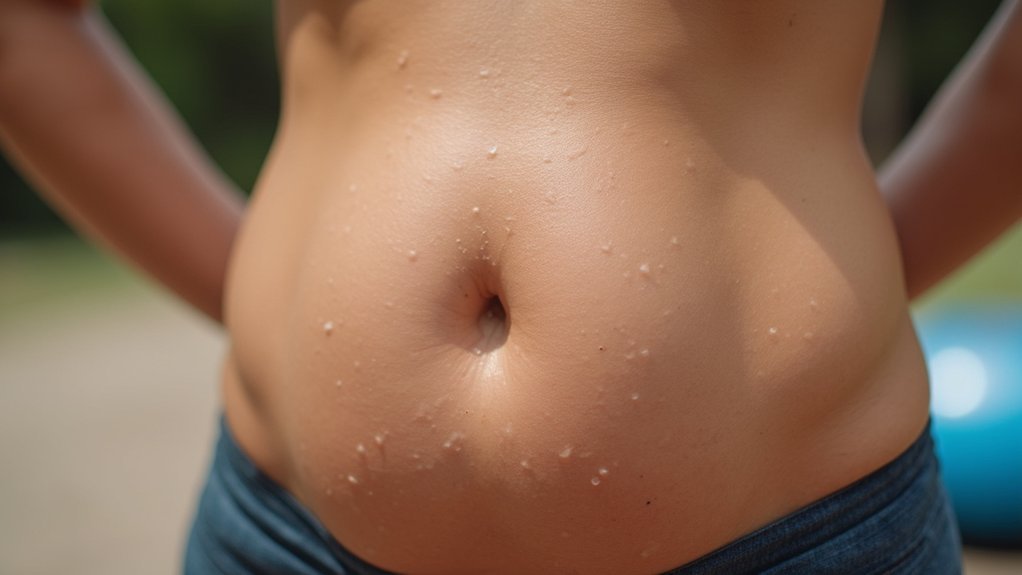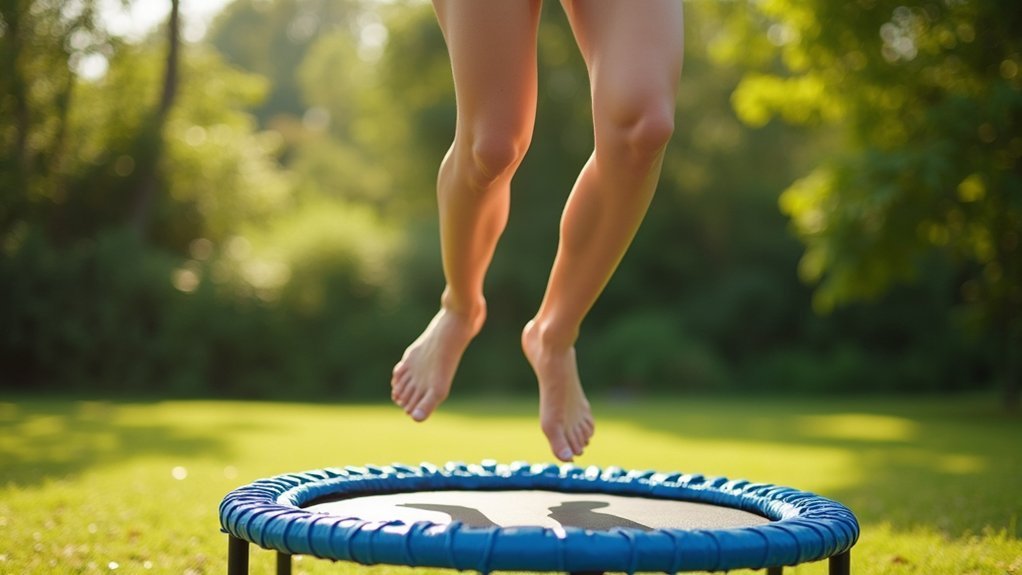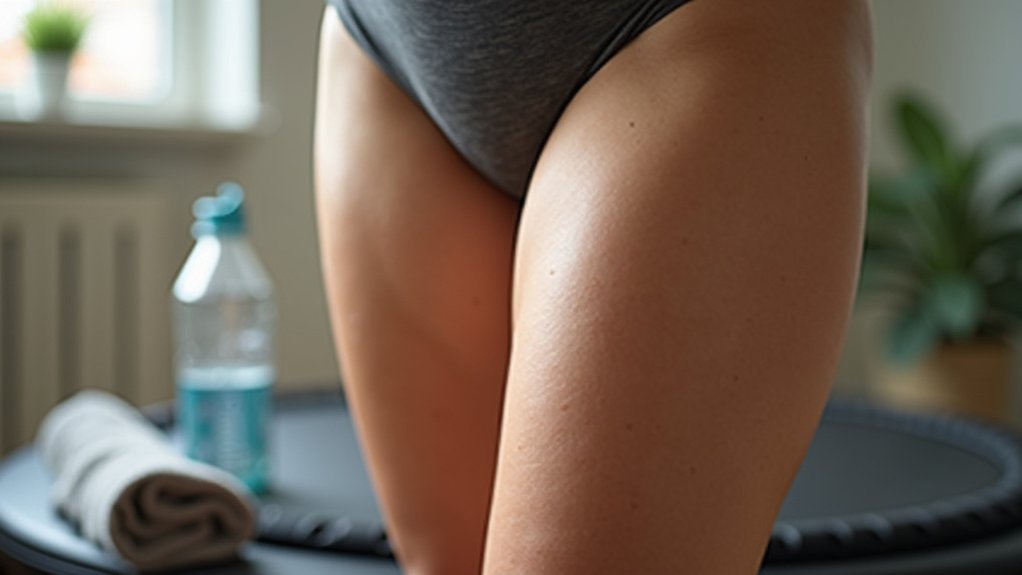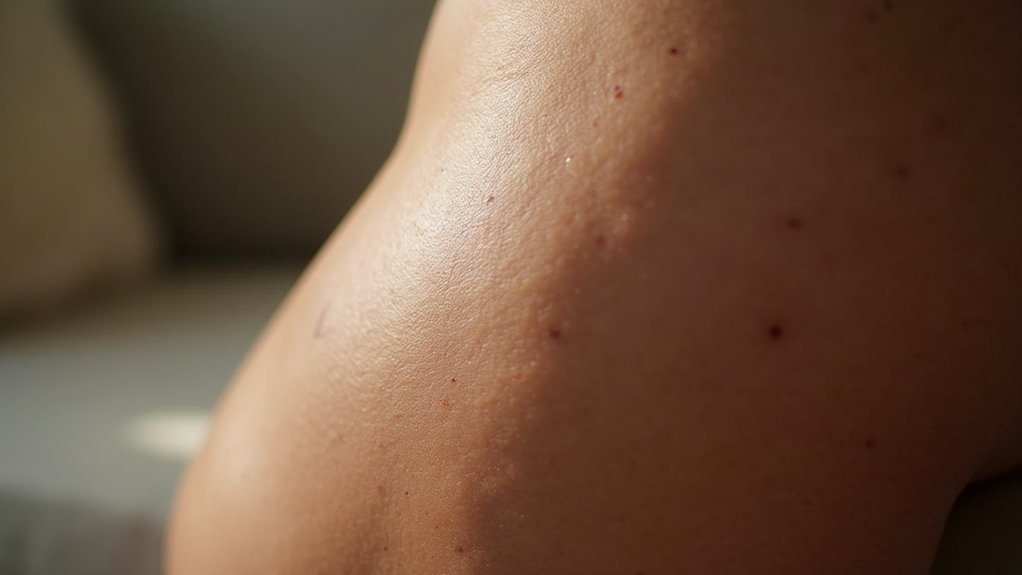Rebounding can reduce cellulite appearance within 2-3 weeks with consistent practice (15 minutes, 3-4 times weekly), but significant results typically take three months. You’ll likely notice improvements first in areas with higher lymphatic density like calves and outer thighs, while stubborn thigh cellulite takes longer. Expect temporary skin plumping after sessions and gradual improvements in skin elasticity over time. The journey combines both immediate effects and lasting changes when done properly.
The Science Behind Cellulite Formation During Rebounding

While many people view cellulite as merely a cosmetic issue, its formation involves complex biomechanical and hormonal processes that occur beneath the skin’s surface.
Cellulite transcends aesthetics, representing intricate subsurface processes involving both biomechanical and hormonal factors.
When you rebound, your body experiences vertical forces that create shear stress on subcutaneous fat and connective tissues. The dimpled appearance results from weakened short septa allowing fat lobules to bulge outward while longer septa remain anchored, creating characteristic depressions.
For women, vertically-oriented connective tissue (unlike men’s crisscross pattern) makes this puckering more visible.
During rebounding, compression temporarily redistributes interstitial fluid and may increase localized metabolic activity.
However, these mechanical forces don’t restructure the underlying septa or permanently alter the connective tissue architecture that causes cellulite’s appearance.
Realistic Timeline for Seeing Cellulite Changes From Rebounding
You’ll notice initial improvements in skin appearance within 2-3 weeks of consistent rebounding, as circulation and lymphatic flow begin to improve.
Most people experience significant cellulite reduction after three months of rebounding for at least 15 minutes, 3-4 times weekly.
To maintain your results long-term, you’ll need to incorporate rebounding as a permanent fixture in your fitness routine, adjusting intensity and duration as your body adapts. Enhanced lymphatic drainage helps your body continuously flush toxins that contribute to cellulite formation.
Initial Bounce-Back Benefits
Once your feet start bouncing on a rebounder, your body responds immediately with several cellulite-fighting mechanisms. Blood circulation increases instantly, delivering nutrients to skin cells while the rhythmic bouncing stimulates your lymphatic system, helping flush toxins that contribute to that dimpled appearance.
You’ll notice temporary plumping of the skin during and shortly after sessions, which visibly reduces cellulite dimples for a few hours. The bouncing motion activates muscles in cellulite-prone areas—thighs, hips, and buttocks—from your very first session. The exercise helps strengthen these areas through full-body movement, improving muscle tone which is crucial for reducing the appearance of cellulite.
While these initial benefits are primarily short-term, they establish the foundation for lasting change. Your metabolism gets a brief boost during rebounding, burning calories that, when combined with consistent practice, will gradually impact the fat stores causing cellulite.
Three-Month Transformation Timeline
Most rebounding enthusiasts begin noticing substantial cellulite reduction around the three-month mark, though your personal timeline will vary based on several factors.
Your metabolic rate, the size of affected areas, and your overall lifestyle habits will influence how quickly you see results.
For ideal progress, you’ll need consistency in your rebounding routine—ideally combined with complementary approaches.
Consider pairing your rebounding with proper nutrition, adequate hydration, and perhaps high-power radiofrequency treatments for enhanced effectiveness.
Document your journey by taking regular photos and measurements to track subtle changes that mightn’t be immediately visible day-to-day.
Be patient with your body’s response and set realistic expectations—while three months typically brings visible improvement, your unique body composition and genetics will determine your exact results.
Maintaining Long-Term Results
After seeing initial improvements at the three-month mark, your focus should shift toward preserving those hard-earned results.
Most cellulite treatments deliver effects lasting between two to five years, with gradual deterioration rather than sudden reversal.
Your lifestyle considerably impacts longevity—regular exercise, balanced nutrition, hydration, and limiting alcohol and smoking all extend results.
Treatments like Avéli and Cellfina typically last longer than others, while bio-stimulator fillers continue promoting collagen production for extended benefits.
For ideal maintenance, consider scheduling periodic touch-up sessions, especially if your lifestyle isn’t perfectly disciplined.
These maintenance treatments become more essential for those with advanced cellulite or less elastic skin.
Remember that individual factors like hormonal changes and severity of your original condition will influence how long your results last.
Before and After: What Real Rebounding Results Look Like
Many wonder what their bodies will actually look like after committing to a rebounding routine. You’ll notice enhanced circulation within days, while visible cellulite reduction develops progressively over weeks of consistent bouncing.
The transformation timeline varies based on your commitment level. Quick 10-minute daily sessions improve lymphatic drainage, but substantial fat loss and muscle toning require 12-20 weeks of high-intensity work. Your results accelerate with 3-5 weekly sessions combined with a caloric deficit diet. The rebounding activity stimulates blood circulation to the skin’s surface, which is crucial for cellulite reduction.
Most users experience tightening in quadriceps, glutes, and calves alongside improved skin elasticity. TikTok testimonials highlight noticeable improvements within 10 days of daily practice.
Remember that genetics influence your ceiling results, and plateaus require adjusting your routine’s intensity periodically. Quality equipment also greatly impacts your progress.
Why Some Areas Respond Better to Rebounding Than Others

Your body’s response to rebounding varies dramatically based on the natural fat distribution in different areas.
You’ll likely notice faster improvements in regions with higher lymphatic node density, which explains why thighs and buttocks often show visible cellulite reduction before other areas.
The effectiveness of your rebounding routine depends on how well you’re engaging muscles in problem areas while simultaneously stimulating the lymphatic drainage that’s unique to each part of your body. The “spoiled child” exercise that mimics vibrating plate benefits can be particularly effective for stubborn cellulite areas.
Target Area Fat Distribution
Though cellulite affects many body regions, not all areas respond equally to rebounding exercises. Your thighs and hips are particularly stubborn due to their unique fat composition. These areas contain larger adipocytes with more pronounced fibrous septae running perpendicular to the skin surface, creating that characteristic dimpling.
Unlike your abdomen, thighs experience reduced blood circulation, which slows metabolic fat breakdown. This vascular inefficiency, combined with tighter fascial networks and thinner skin, makes thigh cellulite more visible and treatment-resistant.
When you rebound, the oscillation creates fluid displacement that targets these problem areas effectively. The repetitive muscle engagement during bouncing drives localized lipolysis, particularly in your thighs.
High-impact rebounding sessions will yield better results than low-impact ones by generating greater mechanical pressure on stubborn fat deposits.
Lymphatic Drainage Variations
While rebounding exercises benefit most parts of your body, lymphatic drainage efficiency varies greatly between different anatomical regions.
You’ll notice faster results in areas with superficial lymphatic networks like your calves and outer thighs compared to denser tissues that resist drainage.
Areas prone to fluid stagnation (inner thighs) often show greater initial circumference reductions—sometimes up to 0.3 cm after a single session. Using light pressure techniques similar to those used in lymphatic drainage massage can enhance these results.
However, these are temporary fluid shifts, not structural changes. Edema-prone zones respond more quickly than fibrous cellulite regions, which is why ankle swelling improves before thigh dimpling.
The intensity of your protocol matters greatly. Weekly sessions produce minimal changes, while intensive daily drainage creates measurable results.
Unfortunately, these improvements require maintenance—once you stop, fluid reaccumulation gradually returns tissues to baseline.
Comparing Rebounding to Other Cellulite Treatment Methods
When evaluating cellulite reduction options, rebounding stands out dramatically against traditional clinical treatments.
While medical procedures like subcision boast 93% satisfaction rates, they come with $1,500-$4,500 price tags per session and potential scarring risks.
You’ll notice rebounding delivers visible results in just 2-3 months compared to 6-12 months for clinical alternatives.
The key difference lies in approach—rebounding tackles cellulite systemically through low-impact lymphatic stimulation and full-body muscle micro-contractions rather than localized tissue manipulation.
For mild to moderate cellulite, your $100-$500 rebounder investment offers comparable effectiveness to expensive medical treatments.
The zero-risk profile and simple 10-minute daily maintenance requirements make rebounding particularly attractive, especially when paired with clinical therapies for enhanced results.
The Role of Consistency in Rebounding Cellulite Reduction

Consistency serves as the cornerstone of effective cellulite reduction through rebounding.
You’ll need to commit to daily sessions of at least 10 minutes to see visible improvements in 2-3 weeks. This regular bouncing activates your lymphatic system, continuously removing toxins that contribute to cellulite formation.
Your body requires this steady mechanical stimulation to enhance collagen production and improve skin elasticity.
The muscle contractions during rebounding gradually transform fat into lean tissue while boosting your metabolism. Most users notice initial dimpling reduction within 2-8 weeks, with ideal results appearing after 2+ months of daily practice.
When to Expect Plateau in Your Rebounding Journey
Most rebounders experience a progress plateau around the 6-12 week mark when muscles adapt and cellulite reduction slows.
You’ll recognize this plateau through unchanged thigh measurements, stagnant skin elasticity, or consistent dimpling patterns in your progress photos over a 4-week period.
Breaking through requires strategic adjustments like adding weighted vests, incorporating interval training, or pairing your rebounding with targeted myofascial release techniques.
Identifying Progress Stalls
Many rebounding journeys toward smoother skin reach temporary standstills despite your best efforts. Understanding when these plateaus typically occur can help you adjust expectations and strategies accordingly.
| Plateau Type | Expected Timeline |
|---|---|
| Early-stage | 3-6 months after lifestyle changes |
| Topical treatments | 8-12 weeks as skin adapts |
| Post-procedure | 6-12 weeks when collagen remodeling slows |
| Treatment-specific | 6-8 sessions for RF/ultrasound therapies |
| Physiological | Immediate during hormonal fluctuations |
You’ll notice progress stalls most frequently during treatment shifts or when your body adapts to current interventions. Watch for warning signs like persistent fluid retention following sodium intake or diminished results despite consistent treatment schedules. If you’ve seen no improvement after six months, it’s time to reassess your approach, especially if dealing with advanced fibrosis.
Overcoming Plateau Phases
While you’re diligently following your cellulite treatment regimen, you’ll likely encounter periods when progress seems to halt completely—these plateau phases are normal and predictable parts of your rebounding journey.
When you hit a plateau, first examine biological factors at play. Genetics, fibrosis, and hormonal changes can all affect your results.
Don’t get discouraged; instead, pivot your approach.
Try incorporating dietary adjustments like reducing sugar intake and increasing hydration.
Consider advanced treatments such as radiofrequency or LED phototherapy to complement your routine.
Velashape III can effectively tone loose skin when other methods stall.
Factors That Enhance or Limit Your Rebounding Results
Your success in reducing cellulite through rebounding doesn’t depend solely on how often you jump. Genetics play a notable role, potentially limiting improvements based on inherited traits that affect skin elasticity and fat distribution.
Genetics may set boundaries for your cellulite reduction journey, regardless of your rebounding dedication.
Dietary habits greatly impact your results—prioritize hydration, antioxidant-rich foods, and fiber to support skin health and toxin removal.
Lifestyle factors like adequate sleep, stress management, and avoiding smoking complement your rebounding routine.
The effectiveness of rebounding stems from improved blood circulation and lymphatic drainage, which help eliminate toxins and deliver nutrients to skin tissues.
However, a sedentary lifestyle between sessions, unrealistic expectations, and excess body weight can undermine your progress.
Remember that rebounding works best as part of a thorough approach to wellness, not as a standalone solution.
Common Misconceptions About Rebounding and Cellulite
Misconceptions about rebounding and cellulite often lead to disappointment when results don’t match expectations. Understanding the reality behind these myths can help you set achievable goals and appreciate the true benefits of this exercise.
| Misconception | Reality | What to Expect Instead |
|---|---|---|
| Overnight results | Cellulite reduction takes 12-20 weeks | Gradual improvements with consistency |
| Weight loss always reduces cellulite | Not effective for everyone, especially those with normal BMI | Focus on circulation and skin health |
| Rebounding alone is sufficient | Works best as part of a thorough approach | Combine with proper nutrition and other treatments |
| More is always better | Excessive exercise without recovery can be counterproductive | Balance intensity with adequate rest |
| One-size-fits-all approach works | Individual factors affect results considerably | Personalized program yields best outcomes |
Rebounding works effectively on cellulite because it stimulates the lymphatic system, which is crucial for removing toxins that contribute to cellulite formation. The increased lymph flow during regular trampoline exercise helps flush out these waste materials while improving overall circulation to affected areas.
Combining Rebounding With Other Strategies for Optimal Results
To maximize cellulite reduction benefits, rebounding works most effectively when combined with complementary strategies rather than used in isolation. Your results will improve greatly when you pair your rebounding routine with dietary adjustments and other physical activities.
1. Nutrition + Rebounding – Maintain a caloric deficit while increasing fresh foods and hydration.
Reducing processed foods enhances circulation benefits from rebounding and accelerates fat loss.
2. Complementary Exercises – Add strength training to build muscle under affected areas and improve skin appearance.
Stretching exercises help maintain healthy connective tissue.
3. Topical Treatments – Apply caffeine-based creams or retinoids after rebounding sessions when circulation is enhanced, improving their absorption and effectiveness in addressing dermal thickness.
Long-Term Maintenance: Keeping Cellulite at Bay With Rebounding
Successfully reducing cellulite is only half the battle—maintaining those results requires ongoing commitment to your rebounding routine.
The physiological changes from consistent rebounding—improved collagen production, enhanced lymphatic function, and strengthened connective tissue—all help prevent cellulite from returning.
For lasting results, integrate rebounding into your daily life with at least several sessions weekly. The gentle rebounding motion increases lymphatic flow by up to 15 times normal rates, supporting continuous detoxification. Support your efforts with a diet rich in omega-3s, fruits, and vegetables while staying well-hydrated. These lifestyle adjustments amplify the benefits of your rebounding practice.
Remember that inflammation reduction and maintained blood circulation are critical factors in keeping your skin firm. Avoid undermining your progress through smoking or excessive alcohol.
Regularly monitor your results and adjust your rebounding routines to keep them challenging and effective.
The Psychological Benefits Beyond Physical Cellulite Changes
While physical changes from cellulite reduction are visible on the body, the transformative psychological benefits often run much deeper.
You’ll likely experience significant mood enhancement and stress reduction as your body image improves, leading to higher self-esteem and decreased anxiety about your appearance.
These mental wellness improvements often translate into tangible lifestyle changes:
- Increased social participation – You’ll feel more comfortable joining group activities, exercise classes, and social gatherings, strengthening your community connections.
- Reduced psychosocial distress – Diminished appearance concerns can alleviate symptoms of anxiety and depression.
- Sustained confidence – The empowerment you gain from improved body perception often extends to other areas of your life, creating lasting positive effects.
Setting Achievable Rebounding Goals for Your Body Type
Rebounding exercises offer different benefits depending on your unique body type, making personalized goal-setting essential for effective cellulite reduction.
Personalized rebounding strategies are the key to effectively targeting cellulite based on your unique physical composition.
If you’ve been sedentary, focus first on boosting circulation with 5-10 minute sessions. Overweight individuals should combine rebounding with dietary adjustments to maximize fat loss results.
Those who are already muscle-toned can incorporate high-intensity variations to maintain firmness, while post-pregnancy bodies benefit from gradual progression focusing on core and leg-specific movements.
Seniors should adopt modified, low-impact techniques that prioritize safety.
Track your progress using the Cellulite Severity Scale and regular photos to stay motivated.
Remember that circulation improvements appear within weeks, but significant cellulite reduction requires several months of consistency—regardless of your body type.
Frequently Asked Questions
Can Cellulite Return After Professional Treatments Like Cellfina?
Yes, your cellulite can return after Cellfina or other professional treatments. Results typically last 1-3 years before genetic factors, weight changes, and hormonal shifts cause recurrence, despite initially successful outcomes.
How Do Hormonal Changes Affect Cellulite Treatment Outcomes?
Your hormonal fluctuations greatly impact cellulite treatment success. Estrogen dominance worsens dimpling, while menstrual cycles affect results. You’ll get better outcomes by timing treatments during your follicular phase and addressing underlying hormonal imbalances.
Are At-Home Devices Effective Compared to Clinical Treatments?
At-home devices can’t match clinical treatments for cellulite reduction. You’ll see temporary improvements with consistent use, but they’re less effective than professional procedures that deliver longer-lasting results under expert guidance.
Can Cellulite Treatments Work on Post-Pregnancy Skin Changes?
Yes, cellulite treatments can effectively address your post-pregnancy skin changes. Treatments like endermologie and radiofrequency work well after pregnancy, especially when combined with breastfeeding and healthy lifestyle choices. You’ll see noticeable improvements with consistent sessions.
Do Certain Ethnic Backgrounds Respond Differently to Cellulite Treatments?
Yes, your ethnic background influences how you’ll respond to cellulite treatments. Skin thickness, structure, and genetic factors vary across ethnicities, affecting treatment outcomes. You’ll need personalized approaches based on your specific skin characteristics.
In Summary
You’ll see gradual cellulite improvement with consistent rebounding, not overnight miracles. Remember, your results depend on genetics, diet, and commitment to your routine. Focus on celebrating the extensive benefits – improved circulation, lymphatic drainage, and mental wellbeing – alongside any visible changes. With realistic expectations and a personalized approach, you’ll achieve the most sustainable results for your unique body.





Leave a Reply